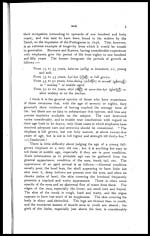Medicine - Veterinary > Veterinary diseases > Elephants and their diseases > Part I - Supply, general hygiene, gear, mounting and restraint
(26) Page 2
Download files
Individual page:
Thumbnail gallery: Grid view | List view

2 A TREATISE ON ELEPHANTS.
and little cultivated country, intersected by rivers and mountain
chains, the elephant finds a congenial home, and it is in this
country, inhabited by shy and retiring people, that a number of
elephants are bred in captivity. Elephants in these parts are used
chiefly for transport purposes between villages, and are a con-
spicuous element in all festivities held by Chiefs. Young tusker
calves, when not more than five or six years of age, find a ready
sale among the numerous Chiefs of the Shan and Laos tribes and
Siamese officials, at prices from three to five hundred rupees. As
much as twelve hundred rupees has been offered for a promising
ten-year old tusker. The wealth of many Chiefs consists largely of
elephants, some of them owning as many as one hundred animals,
and continually adding to the number. One of the great amuse-
ments of the Chiefs is to watch the training of their animals ; this
training begins at an early age, when the elephant is taught to
submit to a man riding on his back or neck ; he is then taught to
carry a saddle and small load, and later to drag timber. When an
animal is being taught to drag, he is taken with a trained elephant
to the sandy bed of a dried-up stream and put in harness ; if he is
obstinate and shows temper, the old elephant is given a long tow
rope which is attached to the youngster, and at a given signal he
moves off, towing the youngster, who frequently falls, but is
nevertheless towed along on his back or side as the case may
be ; after a few such lessons he learns how to drag, but it is not
till an animal reaches the age of twenty that any serious work is
expected of him. Till he is full-grown he is a pet and, if a fine
animal, an object of admiration in a cavalcade of elephants on
festival occasions.
During the last few years purchases for Burma have been made
in Assam and Siam.
AGE.
The limit of age in elephants, and the indications of the age an
individual has reached, are not accurately known. It is natural to
suppose that in the wild state they attain a much greater age than
in captivity. In the latter condition they not infrequently die
prematurely from preventible causes. That they do sometimes live
to a great age is pretty certain. An instance of this is recorded in
Beeton's " Dictionary of Natural History," namely, that amongst the
papers of Colonel Robertson (son of the historian of Charles V.),
who held a command in Ceylon in 1799, shortly after the capture
of the Island by the British, is one showing that a decoy was then
attached to the elephant establishments at Matura, which the records
proved to have served with the Dutch during the entire period of
Set display mode to: Large image | Zoom image | Transcription
Images and transcriptions on this page, including medium image downloads, may be used under the Creative Commons Attribution 4.0 International Licence unless otherwise stated. ![]()
| India Papers > Medicine - Veterinary > Veterinary diseases > Elephants and their diseases > Supply, general hygiene, gear, mounting and restraint > (26) Page 2 |
|---|
| Permanent URL | https://digital.nls.uk/75192098 |
|---|



![[Page1]](https://deriv.nls.uk/dcn4/7519/75192097.4.jpg)
